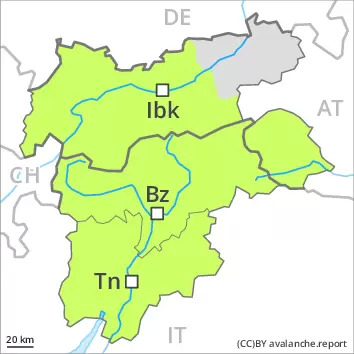
Danger level
 |

The backcountry touring conditions are generally favourable.
Avalanches can in very isolated cases be released in the weakly bonded old snow, in particular by large additional loads. This applies on very steep shady slopes above approximately 2400 m, especially in little used terrain at transitions from a shallow to a deep snowpack. Avalanches can reach medium size.
In addition the wind slabs at elevated altitudes are prone to triggering in very isolated cases still. The wind slabs are clearly recognisable to the trained eye.
Apart from the danger of being buried, restraint should be exercised in view of the danger of avalanches sweeping people along and giving rise to falls.
In particular on steep sunny slopes individual small to medium-sized wet loose snow avalanches are possible.
Snowpack
dp.7: snow-poor zones in snow-rich surrounding
The snowpack will be stable over a wide area.
Shady slopes: In very isolated cases weak layers exist in the centre of the snowpack, especially above approximately 2400 m. The upper section of the snowpack is soft; its surface consists of faceted crystals.
Steep sunny slopes, intermediate and high altitudes: The solar radiation will give rise as the day progresses to moistening of the snowpack.
Tendency
Low avalanche danger will prevail. As a consequence of warming, the likelihood of wet loose snow avalanches being released will increase a little.